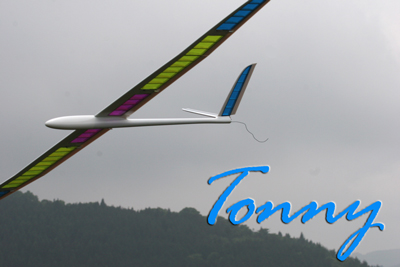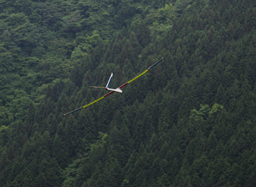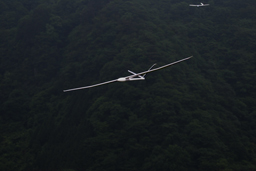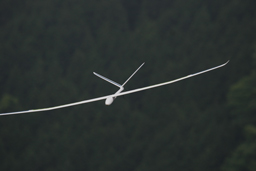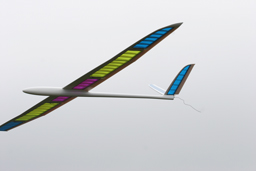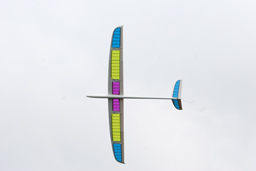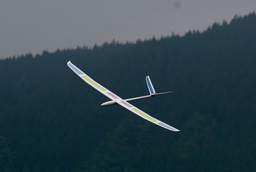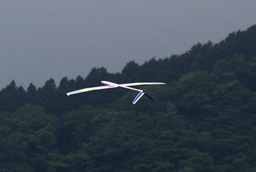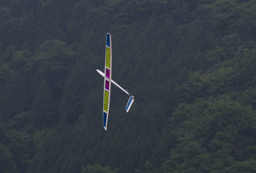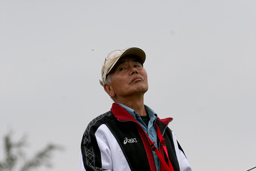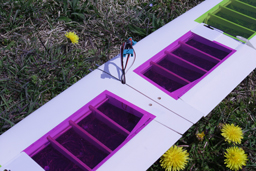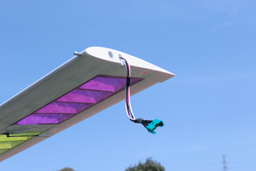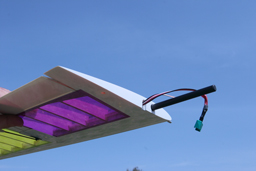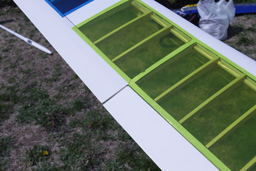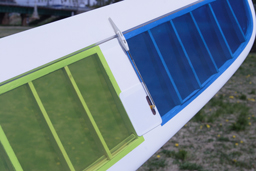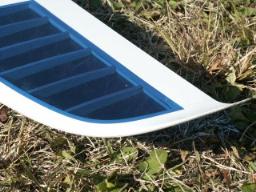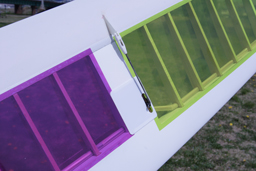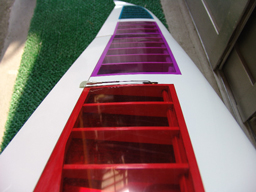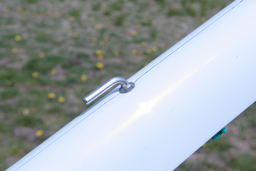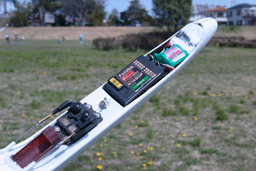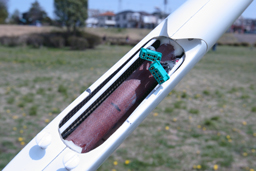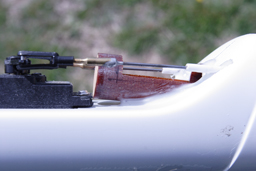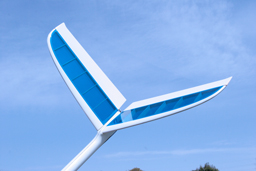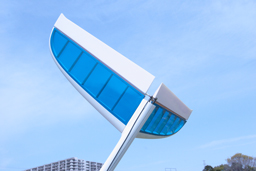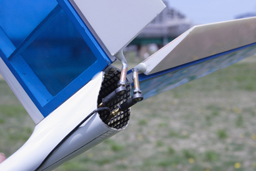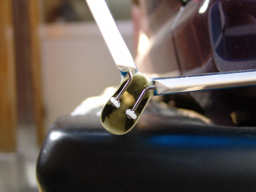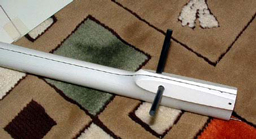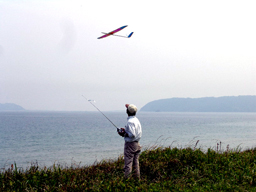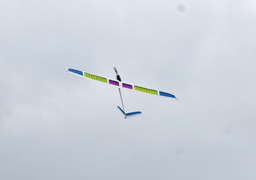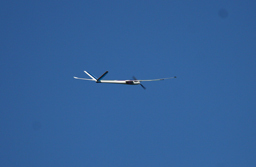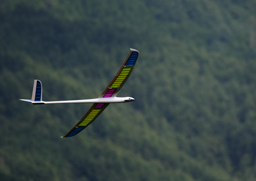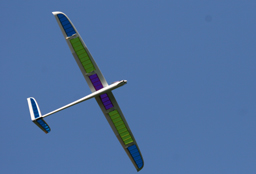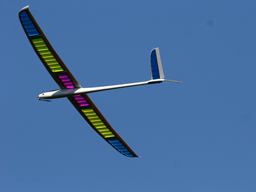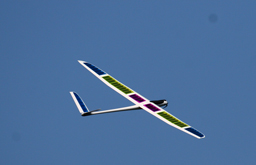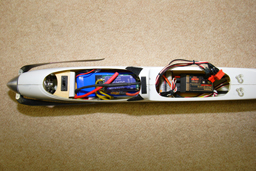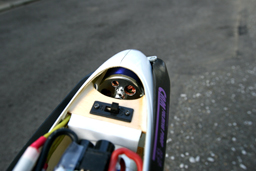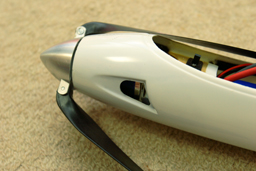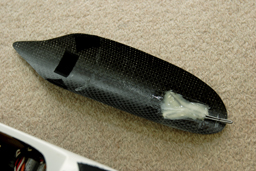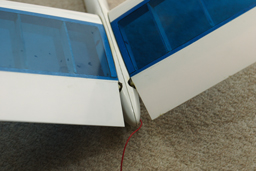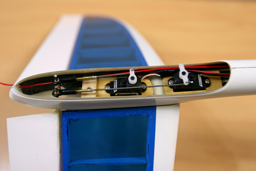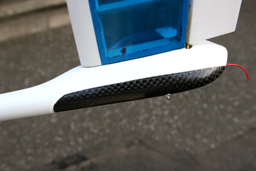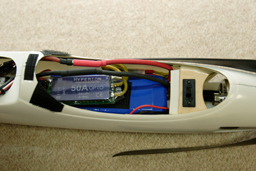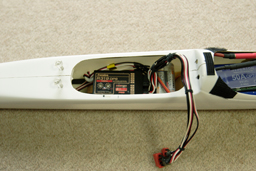 |
| Wing: |
1) Wing profile:SA7037mod
The Profile SA7037 is well known as the profile for thermal gliders, which is used by many thermal models such as ARTEMIS made by Breta model. It is the profile for such a model that flies basically at slow speed. Tonny is the best model for those who loves flying in a relaxed mood. However Tonny flies at considerable speed like a slope ship when Tonny equipped motor and becomes heavy.
2)Wing structure
The main plane is divided into two pieces that are connected by the carbon pole joiner.The trailing edge at the center of the main plane should be taped, because there is no alignment pin at the edge of main plane. It will be easier to mount whole main plane on the fuselage. The D-box of the main plane is comparatively finished to be hard, there would be damaged at the hard landing. So it is comfortable for landing at the slope hill, as well as for the beginner's landing on the flat land. The wing tip end is slightly curled up which has the effect of winglet. As shown the above photo,The main plane is attached by two Nylon screws that will work as a fuse when the main plane attack the trees accidentally.
3)Flaps and Ailerons
The hinge is the skin hinge. Flaps are hinged by the lower surface skin, and the ailerons are hinged by the upper surface skin as shown by the above photo. Therefore, aileron control horn should be put on the lower surface of the aileron, and the flap control horn should be put on the upper surface of the flap on a text basis. As for aileron, it should be on a text basis. However if you use flap as butterfly airbrake with the angle of almost 90 degrees, the flap control horn must be comparatively taller than usual. Mr. Soh, a leader of one of the glider clubs in Kyushu area in Japan, made a special flap control horn for the upper linage. When I looked at the flap linkage cover in the factory kit, the designer intend the lower linkage for flap originally, not but the upper linkage implemented by Mr. Soh These linkage covers seems to be too big for the area that are not covered with Oracover. In other words, Servo and linkage cover covers over the Oracover film. So the simple servo cover plates were adopted this time. When the flap is used as the camber, Tonny seems to be sensitive to down-flap. It is recommended that the flap should not be down so much(see standard trim). Otherwise Tonny will stall much. The flap neutral is very important, The flap must be installed so that the flap should not have any looseness by using strong torque servos.
4)Servos
The Futaba S3150(3.7Kgcm,4.8V), that is high torque, is used for the flaps, The OK S2009 with 9mm, which is very thin, is used for the aileron. The Futaba S3102 is used for V-tail, because it is cost effective. In case of Motor, FutabaS3108 is used. |
 |
| Fuselage: |
1)Fuselage structure
(a) Fuselage for no motor model
The fuselage is molded , the inside is reinforced by the carbon cloth tape. The fuselage for no motor is the nosecone type. The servo bay is very wide and molded, so that the Futaba 9 channel receiver, which is big, can be accommodated.
Tonny may fly at high speed on the slope and we can be enjoy the acrobatic, even without ballast as shown above. To be honest, Tonny is the model that flies slowly. The ballast should be possible to be loaded for the windy day. If you want to fly fast, then I recommend to make the ballast room for Tonny. The ballast helps to make Tonny stable and fly at higher. There is enough room in the fuselage for build the ballast room in the fuselage. In addition, the ballast pipe can be installed upper portion of the fuselage, because the screws for fixing main plane split at the right and left side of fuselage as shown above.
(b) Fuselage for motor model
The fuselage for motor model is composed by the same materials. The inner room of it is made wider than the fuselage for no motor model so that 10cell of NiCd battery can be loaded. The Lithium polymer battery is available now. Hence such a wide room may not be required. The motor models has the motor and battery, hence it would be heavy, then Tonny would change to be a slope racer. You may enjoy slope flying.
Tonny accommodates V-tail servos into its fuselage tail room that can be easily overhauled through its sophisticated tail canopy. In case of such models that accommodates servos into its front room, the v-tail servos are hidden in the deep inside, because the motor and its battery occupy the room in the fuselage, the overhaul servos or adjustment physical trim of linkage is not so easy. The Tonny is well designed among the 2m class models. (Open class models adopts this design in usual.) The shape of the motor fuselage is different from the one for no motor model, because the ball linkage are built in the tail room.
(c) Recommended Motor drive
Nan Model suggest model to be powered either by brushless outer runner motor or in-runner motor (with gearbox). Thanks to front fuse diameter of 38 mm (or up to 42 mm), you can use broader range of popular outer-runner motors without additional cost of gearbox. Catching a thermal is easier with 3 to 4 cells LiPo, for increased wind penetration and energy retention we suggest heavier NiMH cells. There is a room for up to 12 Sub C size cells in the fuselage.
Example drive sets for F5J-7 competition and affordable all around setup:
(example 1)
- Model Motors: AXI 2820/10 brushless outer-runner motor
- Controller: MGM TMM Compro 4012-3 PL brushless controller
- Propeller: 14x8 CAM Aeronaut folding propeller
- Battery: 7 cells GP2200 NiMH 4/5 SC size
(example 2)
- Model Motors: HYPERION Z3019-10Turn
- Controller: HP-TITAN-50-PO
- Battery: HP-LVX2500-3S (11.1V 3S)
- Propeller: Graupner CAM 13x7 folding propeller
- Spinner: 38 diam.
2)Tail plane
The tail plane of Tonny is the molded and is stiff enough because it has the same structure as the main plane. The tail plane is removable passably. The Oracover film are spanned up to the root of of both upper and lower sides of the V-tail as shown by the photo Even though you try to fixed by the adhesive tape, it must be spanned over the film. The only portion that is not covered by Oracover is only the front small area. It is concluded that the tail plane pieces should be attached permanently by the adhesive for safety.
In the Tonny kit, the ball linkage of the V-tail must be implemented by yourself. The control linkage will be made by bending stainless steel rod. It may be a heavy task for the beginners. The ball with hole must be prepared and should be attached to the rod end by soldering. The flux for stainless is required for the soldering. (Please take care of handling the flux, because It is a strong poison.) |
 |
| Flight: |
When Tonny is launched by the bungee code that enable to launch up to 4m class model made by the MULTIPLEX, Tonny ascended up and reached to the highest point. Tonny was released smoothly. It went to the level flight without zooming. If it were windy day, it might zoom. While thermal duration, Tonny flies slowly as usual F3J ship. The control of elevator and rudder might be a little delayed, It is in usual for F3J ship and not a problem.
Mr. Kanoh reported that The motor model of Tonny flew very fast. It was completely different from no motor model ,
The above pictures shows slope flying demonstrated by Mr. Yamada. The slope spot is the home base of Mr. Yamada, who knows the characteristics of that slope. Mr. Kubota looked at the flight by Mr. Yamada, and said ,"I have never seen such a vivid Tonny". The performance of the Tonny can be represented by those words by Mr. Kubota. It is the best point that he Tonny can be enjoyable by anyone. |
 |
| CG&Standard Trim : |
| The Center of gravity and standard trims are shown here. |
